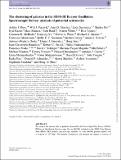The clustering of galaxies in the SDSS-III Baryon Oscillation Spectroscopic Survey : analysis of potential systematics
Abstract
We analyse the density field of galaxies observed by the Sloan Digital Sky Survey (SDSS)-III Baryon Oscillation Spectroscopic Survey (BOSS) included in the SDSS Data Release Nine (DR9). DR9 includes spectroscopic redshifts for over 400 000 galaxies spread over a footprint of 3275 deg2. We identify, characterize and mitigate the impact of sources of systematic uncertainty on large-scale clustering measurements, both for angular moments of the redshift-space correlation function, ξℓ(s), and the spherically averaged power spectrum, P(k), in order to ensure that robust cosmological constraints will be obtained from these data. A correlation between the projected density of stars and the higher redshift (0.43 < z < 0.7) galaxy sample (the approximately constant stellar mass threshold ‘CMASS’ sample) due to imaging systematics imparts a systematic error that is larger than the statistical error of the clustering measurements at scales s > 120 h−1 Mpc or k < 0.01 h Mpc−1. We find that these errors can be ameliorated by weighting galaxies based on their surface brightness and the local stellar density. The clustering of CMASS galaxies found in the Northern and Southern Galactic footprints of the survey generally agrees to within 2σ. We use mock galaxy catalogues that simulate the CMASS selection function to determine that randomly selecting galaxy redshifts in order to simulate the radial selection function of a random sample imparts the least systematic error on ξℓ(s) measurements and that this systematic error is negligible for the spherically averaged correlation function, ξ0. We find a peak in ξ0 at s∼ 200 h−1 Mpc, with a corresponding feature with period ∼0.03 h Mpc−1 in P(k), and find features at least as strong in 4.8 per cent of the mock galaxy catalogues, concluding this feature is likely to be a consequence of cosmic variance. The methods we recommend for the calculation of clustering measurements using the CMASS sample are adopted in companion papers that locate the position of the baryon acoustic oscillation feature, constrain cosmological models using the full shape of ξ0 and measure the rate of structure growth.
Citation
Ross , A J , Percival , W J , Sánchez , A G , Samushia , L , Ho , S , Kazin , E , Manera , M , Reid , B , White , M , Tojeiro , R , McBride , C K , Xu , X , Wake , D A , Strauss , M A , Montesano , F , Swanson , M E C , Bailey , S , Bolton , A S , Dorta , A M , Eisenstein , D J , Guo , H , Hamilton , J-C , Nichol , R C , Padmanabhan , N , Prada , F , Schlegel , D J , Magaña , M V , Zehavi , I , Blanton , M , Bizyaev , D , Brewington , H , Cuesta , A J , Malanushenko , E , Malanushenko , V , Oravetz , D , Parejko , J , Pan , K , Schneider , D P , Shelden , A , Simmons , A , Snedden , S & Zhao , G 2012 , ' The clustering of galaxies in the SDSS-III Baryon Oscillation Spectroscopic Survey : analysis of potential systematics ' , Monthly Notices of the Royal Astronomical Society , vol. 424 , no. 1 , pp. 564-590 . https://doi.org/10.1111/j.1365-2966.2012.21235.x
Publication
Monthly Notices of the Royal Astronomical Society
Status
Peer reviewed
ISSN
0035-8711Type
Journal article
Collections
Items in the St Andrews Research Repository are protected by copyright, with all rights reserved, unless otherwise indicated.

